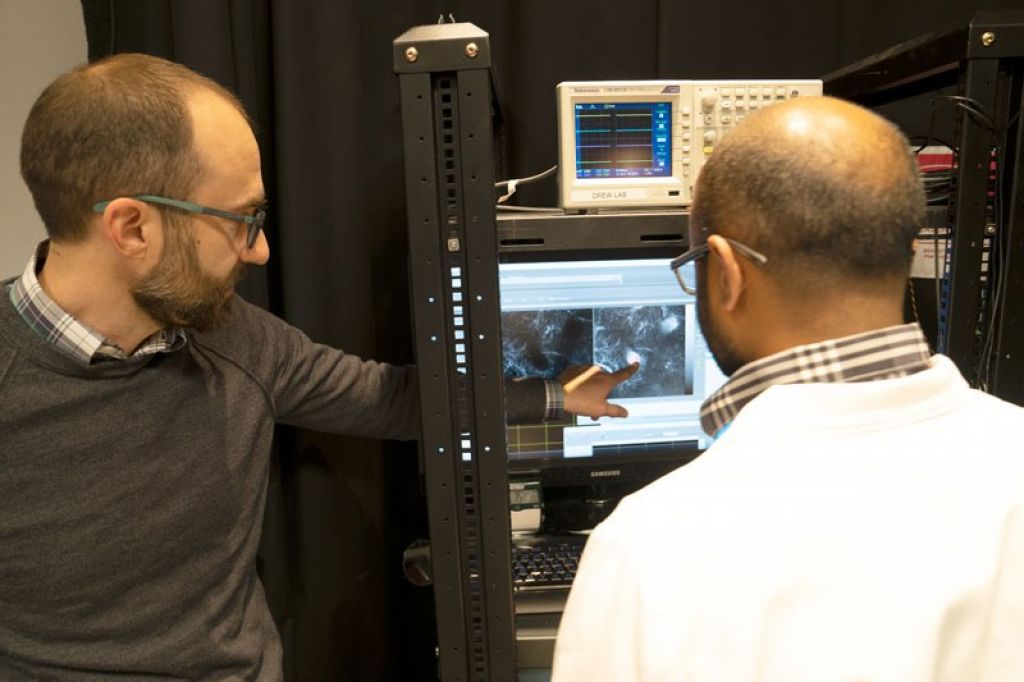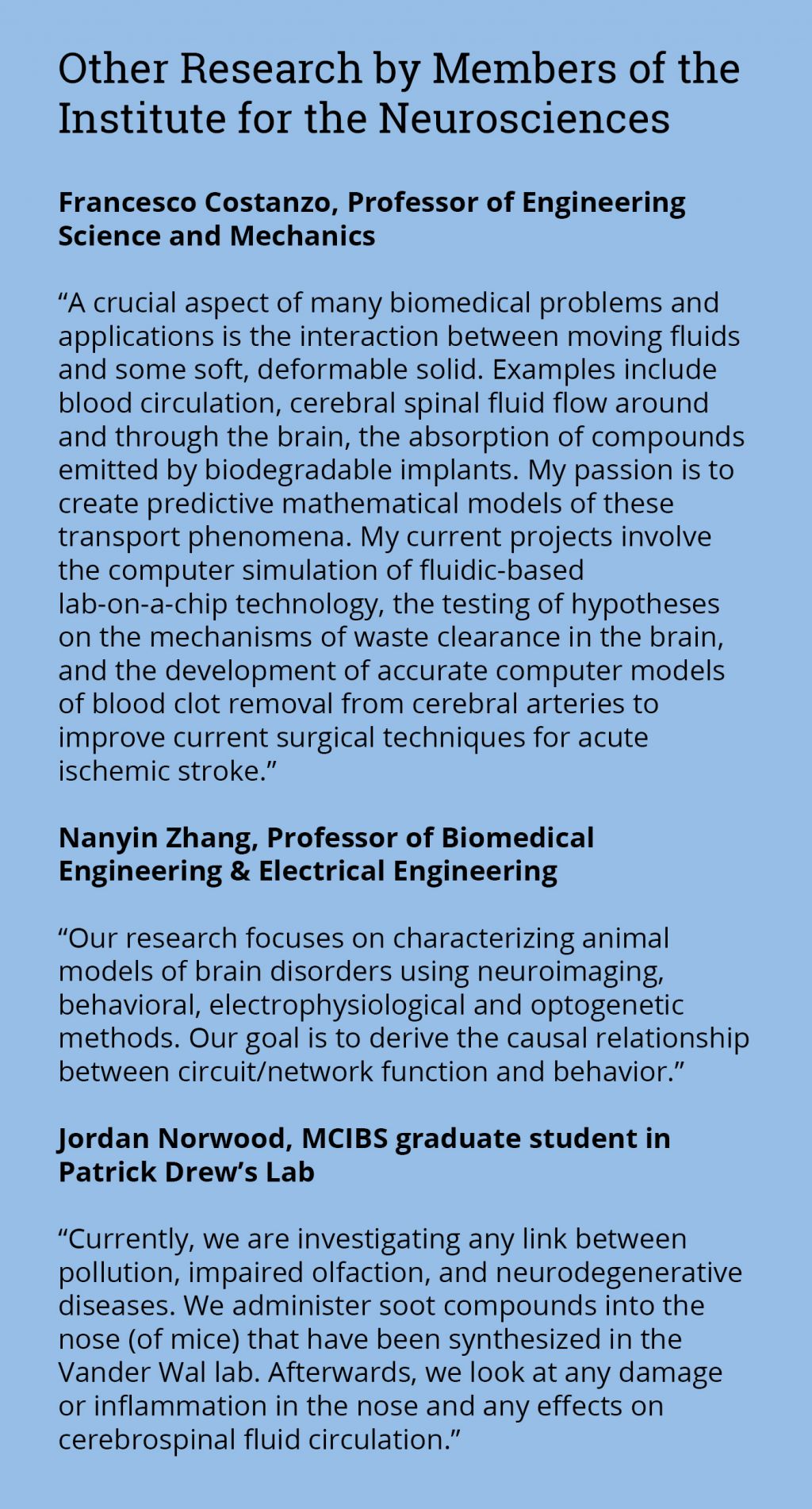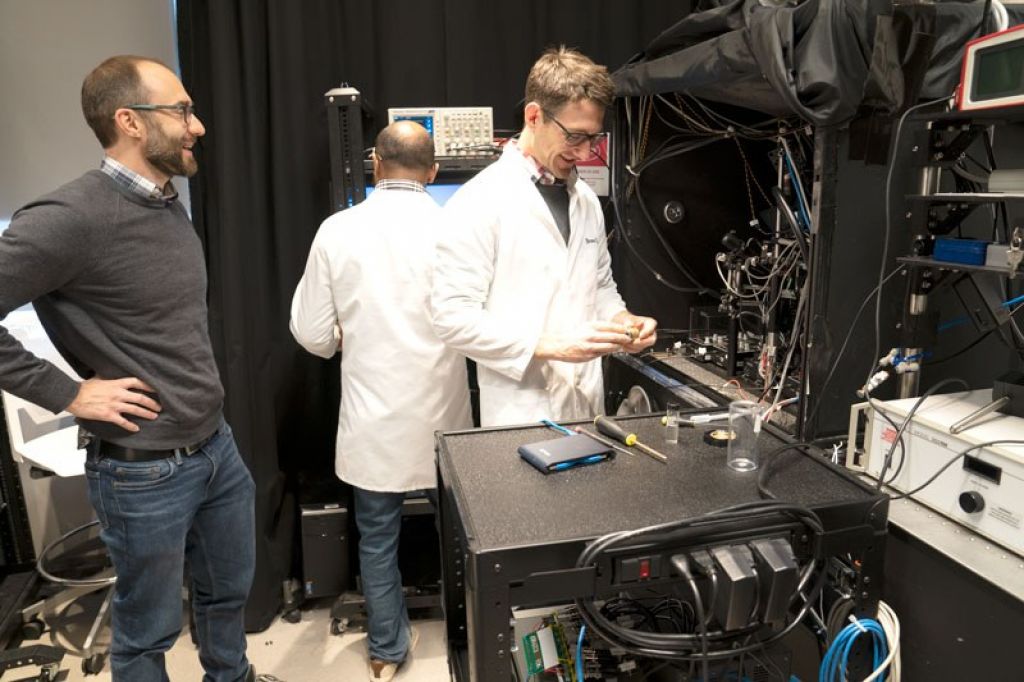Trailblazers: Patrick Drew Demystifies the Mechanics of the Brain

Patrick Drew, Huck distinguished associate professor of neural engineering and neurosurgery, approaches the brain in a very mechanistic fashion.
“The brain is magical and mysterious in some ways, but on another level, it's just physical stuff,” Drew said. “If you want to understand the diseases and how to fix them, you have to understand how the brain works.”
He is currently researching the behavior of cerebrospinal fluid, which surrounds the spinal cord, cushions the brain inside of the skull, and regulates cerebral blood flow.
“We can use the laws of physics to understand how fluid moves around in the brain,” Drew explained. “We're taking techniques and simulations that were developed to figure out how airplanes fly and looking at how cerebrospinal fluid moves. It’s a perfect example of how the engineering world is applied to the neuroscience world.”
Drew was recently named associate director of Penn State Neuroscience Institute and has been a part of Penn State‘s neuroscience community since 2010. The Institute promotes collaboration in basic and clinical research studies that increase understanding of the normal and diseased nervous systems, translation of basic research findings into new treatments for neurological and neurobehavioral diseases and disorders, and improvement of care for patients with neurological and neurobehavioral diseases and disorders.
“The Institute provides oversight and coordination for education, research, patient care, and outreach,” Drew said. “We want to promote an intellectual environment that enhances the interdisciplinary neuroscience experience from the undergraduate to postdoctoral levels.”

The 52 faculty members of the Institute represent a wide range of specialties, including anthropology, biomedical engineering, neurosurgery, and physics. The Institute also facilitates collaboration and networking between scientists and students in the areas of neuroscience at the Penn State Hershey College of Medicine and the University Park campus.
Drew and Krish Sathian—director of the Institute, professor and chair of neurology, professor of neural and behavioral sciences, and professor of psychology—have started a joint effort to bring together faculty members from both campuses to present research to each other and share information through an ongoing series of neuroscience seminars and an annual retreat.
“Sharing our research with one another benefits everyone involved, and enriches our work both individually and collectively,” Drew said.
Drew is currently embracing Penn State’s culture of trans-disciplinary research through a collaborative project with Randy Vander Wal, a professor in the Department of Energy and Mineral Engineering and a combustion chemist. The pair are working to determine if air pollution in the form of soot particles can kill olfactory sensory neurons and block cerebral spinal fluid outflow. Reduced cerebral spinal fluid movement might be linked to neurological diseases such as Alzheimer's and Parkinson's.
“In your nasal passages, there's this complicated cartilaginous structure and a bunch of neurons, and each one of them has receptors for odorants,” Drew explained. “They send their axons, which are these long thin cables, into the brain to transmit electrical signals. They pass through the cribriform plate in your skull, which is basically full of little holes. The space in between the axons is a very nice conduit for fluid. If you kill these axons, these holes plug up. You don't have this sort of freeway for fluid to come through,” he said.

Drew has other innovative collaborations in the Institute for Neuroscience with colleagues that cross disciplinary boundaries. He is working with Nanying Zhang, Professor of Biomedical Engineering & Electrical Engineering, who does functional medical resonance imaging (fMRI) in rodents. They are exploring how neurovascular coupling changes as animals age. Many of the old studies of neurovascular coupling were done under anesthesia, which is very disruptive. It causes the heart rate to go very low, it directly affects the blood vessels, and it decreases the metabolic rate of the brain.
“People often refer to anesthesia as ‘going to sleep’ and that's not correct,” Drew said. “It's nothing like sleep. It's more like a temporary reversible coma. Scientists have made quantitative measurements of brain metabolism in humans and animals that are anesthetized and awake, and anesthesia decreases brain metabolism by 50%. People who are in a vegetative coma and have never awoken have a brain metabolic rate of about 50%. It's not a very good model for what's happening when we are awake.”
Research from Drew’s lab resulted in a finding published in Nature Neuroscience two years ago; spontaneous neural signals were driven by fidgeting, or, in the case of mice, constantly moving their whiskers and resulted in an increased blood flow.
“There's something called resting state fMRI, where humans or animals were put in these magnets without stimulation but still showed fMRI signals. One question is, where do these signals come from? We were trying to measure what blood vessels and neurons are doing during these spontaneous signals.”
“This is analogous to people moving their eyes around and other attentional effects. If you look at people who constantly fidget and make very small movements, like blinking our eyes, that drives MRI signals. Swallowing, sighing, breathing, and touching all creates signals in our brains. Lots of tiny things we do constantly that drive this. A lot of it could just be this difference in fidgeting that's driving it.”
Drew finds this a very interesting question.
“Why do we constantly move?” He asked. “We had a review published just a few months ago in The Neuroscientist about fidgeting and why it drives these ubiquitous brain signals. Why it happens we're not so sure. And surprisingly, if you look through the psychology literature, there's little study of this. I think it's going to be a burgeoning field. Several papers have come out since we published that these fidgeting signals drive brain-wide neural activity. And there's a lot of increase in the ability for people to use software to track movement. Before you had to sit and trace things on a videotape and it was very difficult. Developments in computer vision, deep learning, and algorithms allow us to do this tracking easily. I think what one growth area for neuroscience is linking this complicated behavior with this ongoing neural activity.”
Drew is currently working hard to understand how neural activity is related to blood flow signals. This is important for interpreting human fMRI; we know that the aging process reduces the blood flow to your brain and the faster this blood flow goes down, the more likely you are to develop dementia and other problems. Understanding how that's controlled is a fundamental physiological question that is very relevant to many different practical matters as well.

On this front, he’s collaborating with Francesco Costanza, professor of Engineering Science and Mechanics. “We're modeling cerebral spinal fluid motion,” Drew said. “Blood vessels dilate when neurons are more active, and they push fluid around in the brain. This is a potential way to drive circulation of cerebral spinal fluid. That’s important because your brain doesn't have a normal lymphatic system like the rest of your body, where you have these things taking the junk out.”
When asked to share some little-known features of the human brain, Drew cited some striking facts. “Your brain is very demanding, metabolically speaking. It makes up only about 2% of your body weight but uses about 25% of your energy.”
Your brain requires the lion’s share of blood flow in your body, too. Broken down by mass, the amount of blood that flows through your brain when your body is at rest—say, just sitting there scrolling through your phone—is equal to the amount that flows through your thigh muscles when you’re exercising at full force.
Drew believes it’s very important for Penn State to continue to expand its neuroscience research portfolio.
“Neuroscience accounts for 22% of the National Institutes of Health (NIH) budget right now,” he pointed out. When asked what Penn State is uniquely positioned to contribute to the field, Drew cited the university’s strong engineering reputation and capacity to develop novel techniques as two important strengths to build upon.
“When I started to work in neuroscience 25 years ago, people would record one to five neurons at time electrically,” he explained. “And they were using the same techniques that were developed by Hubel and Wiesel who won the Nobel Prize in the late 1950s. What people can do now is record from hundreds or thousands of neurons at a time. They've developed better electrodes and better imaging technologies.
Many of these things have been pushed by engineers. Because we have this strong engineering background, we can pull these people in from different fields.”